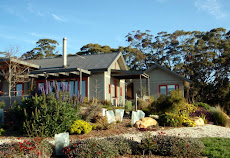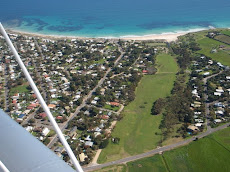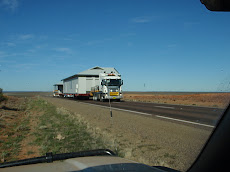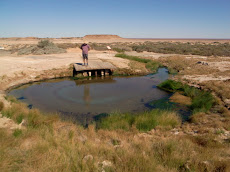Eighty Mile Beach arcs between Broome and Port Hedland, with a well publicised campsite halfway along it. We found a spot behind the dune separating it from the beach, and again watched a now cooler sunset, in peace and some solitude. Broome is a gateway to and from the Dampier Peninsula and the Kimberly, with tropical vegetation that extends right across the top end. When you leave to the south, the landscape becomes semi arid heath quite rapidly. By the time you reach Port Hedland you know you have shifted into a different world altogether. The red iron oxide lies over everything. This company town, the bridgehead for a lot of the iron ore trains, sports what were company houses, fibre cement sheet shacks of about 8 to 10 squares tha t ride the ridge overlooking the coast. All use solar panels that are thick with oxide and cannot be of much use. Chain wire front and side fences separate 15 metre blocks of land that are short of garden hobbyists. Our jaws dropped when we were told that these ridge top houses were selling for $1m. You might pay $80,000 for one in Woodend!.Such is the world of mining here in WA. The miners are distorting so much during this boom, and we hear increasing numbers of hopeful new owners are beginning to pay the price in Perth, as some suburbs there are now dropping.
t ride the ridge overlooking the coast. All use solar panels that are thick with oxide and cannot be of much use. Chain wire front and side fences separate 15 metre blocks of land that are short of garden hobbyists. Our jaws dropped when we were told that these ridge top houses were selling for $1m. You might pay $80,000 for one in Woodend!.Such is the world of mining here in WA. The miners are distorting so much during this boom, and we hear increasing numbers of hopeful new owners are beginning to pay the price in Perth, as some suburbs there are now dropping.
West of Port Hedland lies the other mining town, Dampier; and between these is Karratha which was built as an overflow for Dampier, and the old towns of Roebourne and Cossack. Roebourne was established by pastoralists after explorer Grego ry reported on the suitability of this country for carrying sheep (it wasn’t), and Cossack was built around the same time, being the first place that pearls were discovered and harvested. Broome took over the trade when the shell was exhausted. Cossack is now the host of the annual art prize, but is otherwise a ghost town of fine old stone buildings. The history is well documented in the old gaol, and Cossack sports a fine old courthouse. We watched a race horse being exercised on the beach, and went in search of our first petroglyphs since the Flinders Ranges – rock art engraved into the hard igneous rock.
ry reported on the suitability of this country for carrying sheep (it wasn’t), and Cossack was built around the same time, being the first place that pearls were discovered and harvested. Broome took over the trade when the shell was exhausted. Cossack is now the host of the annual art prize, but is otherwise a ghost town of fine old stone buildings. The history is well documented in the old gaol, and Cossack sports a fine old courthouse. We watched a race horse being exercised on the beach, and went in search of our first petroglyphs since the Flinders Ranges – rock art engraved into the hard igneous rock.
As we neared the Burrup Peninsula, north of Dampier, we were told of the extraordinary quantity  of petroglyphs to be found almost everywhere, and sure enough we soon saw images of turtles and wallabies, boomerangs and “strong men” with wonderful head dresses. This pic apparently represents white sailor arrivals. We stopped a night on the shelly beach at Hearson/s Cove, where Gregory first landed back in 1860 something. The entire landform is made up of jumbles of rock that appear half quarried and then left. Spinifex fills all the gaps, and euros squat and eye you carefully from otherwise inaccessible perches – we counted 10 early in the morning. As they move the rocks sometimes overbalance, making a “chink” sort of metallic sound, so rich in iron are they. Nestled in between the tall ridges sits an alien from another world. Woodside control most that happens up here on the Burrup Peninsula, and they have built part of their LNG plant near Hearson’s Cove. The contrast of searching amongst rocks for signs of aboriginal habitation, next to this scene from a sci-fi movie, was extreme. Across the peninsula though, lies Woodside’s main LNG plant, which is being expanded continuously to meet demand, particularly from China. It is a monumental project, and those of us who can remember noises about a small exploration company finding gas back in the 1980’s and who failed to buy, can rue our lack of courage!
of petroglyphs to be found almost everywhere, and sure enough we soon saw images of turtles and wallabies, boomerangs and “strong men” with wonderful head dresses. This pic apparently represents white sailor arrivals. We stopped a night on the shelly beach at Hearson/s Cove, where Gregory first landed back in 1860 something. The entire landform is made up of jumbles of rock that appear half quarried and then left. Spinifex fills all the gaps, and euros squat and eye you carefully from otherwise inaccessible perches – we counted 10 early in the morning. As they move the rocks sometimes overbalance, making a “chink” sort of metallic sound, so rich in iron are they. Nestled in between the tall ridges sits an alien from another world. Woodside control most that happens up here on the Burrup Peninsula, and they have built part of their LNG plant near Hearson’s Cove. The contrast of searching amongst rocks for signs of aboriginal habitation, next to this scene from a sci-fi movie, was extreme. Across the peninsula though, lies Woodside’s main LNG plant, which is being expanded continuously to meet demand, particularly from China. It is a monumental project, and those of us who can remember noises about a small exploration company finding gas back in the 1980’s and who failed to buy, can rue our lack of courage!




















































































































No comments:
Post a Comment